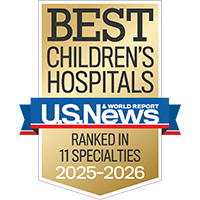Saving future lives
500+ UCSF investigators are researching cures for hundreds of childhood and adult diseases.


Germ cells are the cells that normally develop into eggs in females and sperm in males. If they develop abnormally, they may turn into germ cell tumors. These relatively rare tumors can be malignant (cancerous) or benign (noncancerous).
When germ cell tumors form in gonads (ovaries or testicles), they are called gonadal germ cell tumors. Most ovarian and testicular tumors in children originate from germ cells.
When germ cell tumors occur outside the reproductive organs, they are called extragonadal germ cell tumors. These usually occur because the cells failed to migrate to their proper location in the body. Many researchers believe that extragonadal germ cell tumors are related to developmental problems that arose before birth.
About 90% of all germ cell tumors are gonadal. Most of the remaining 10% occur in the chest, lower back or head.
Germ cell tumors represent about 3% of all childhood cancers. Researchers haven't identified any environmental factors, such as exposure to toxins, that increase the risk of this cancer. Among children, cure rates for most types of germ cell tumors are good – above 90%.

Top 10 in the nation and best in Northern California for cancer care

Ranked among the nation's best in 11 specialties
There are several types of benign (noncancerous) and malignant (cancerous) germ cell tumors. Some of the main ones are described below. It's also possible to develop a mixed germ cell tumor, a cancer that forms from two or more types of germ cell tumor.
Embryonal carcinoma is often found in mixed germ cell tumors, although among older boys, it may be the only tissue type found in testicular germ cell tumors. The tumor may produce proteins called alpha-fetoprotein or beta-human chorionic gonadotropin.
Embryonal carcinomas often resemble tissues of early embryos. They can be aggressive, meaning they grow rapidly and spread.
Endodermal sinus or yolk sac tumors are found in gonadal and extragonadal sites. They almost always produce alpha-fetoprotein.
Among children, this is the most common type of malignant germ cell tumor, frequently occurring in the ovary, testicle and sacrococcygeal region (near the tailbone).
A yolk sac tumor that occurs outside of the ovary or testicle requires surgery and chemotherapy – regardless of the cancer's stage – because of the aggressive nature of the disease. Some endodermal sinus tumors in the ovaries or testicles can be completely removed. In these instances, chemotherapy is unnecessary – unless the cancer recurs.
Germinomas are usually malignant. Germinomas are called dysgerminomas when located in the ovaries and seminomas when located in the testicles.
Among children, germinomas occur most frequently in the ovaries of prepubescent or adolescent females.
Teratomas originate from cells that can form all kinds of tissues. These benign tumors may have rudimentary hair, teeth, intestines, skin or other tissues scattered within the tumor mass.
Teratomas may occur at the usual germ cell sites, including the ovaries and testicles, as well as in unusual sites, such as the neck, stomach and area around the kidneys. Tumors in the neck may be particularly challenging in the newborn period because they may distort or obstruct the baby's airway.
If the tumor is completely removed, no additional therapy may be needed other than regular follow-up visits.
Germ cell tumor symptoms depend on where the tumor is located in the body.
Ovarian germ cell tumors can be difficult to detect and may grow large before they produce symptoms. These tumors usually aren't discovered until age 10 or later. A possible sign is swelling of the abdomen.
Testicular tumors are often detected at an early age because they become noticeable in the scrotum or cause pain.
These tumors are located in the space between the lungs (the mediastinum). Malignant mediastinal tumors may cause:
Presacral tumors are in the area above or in front of the sacrum (the triangular bone at the base of the spine that forms part of the pelvis). A malignant presacral germ cell tumor usually appears as a mass in the lower abdomen or buttocks of an infant or young child.
These tumors may cause difficulty with:
Benign and malignant presacral germ cell tumors are much more common in children than in adults. In children younger than 6 months, these tumors are benign in 98% of cases. In children older than 6 months, the tumors are malignant in about 65% of cases.
Tumors in the pineal gland, a pea-sized gland in the middle of the brain, cause symptoms by pressing on parts of the brain or by interfering with the normal flow of cerebrospinal fluid, the clear fluid that circulates around the brain and spinal cord. Almost all pineal germ cell tumors occur in patients younger than 40.
Symptoms may include:
If the tumor begins to produce hormones, the child may show physical signs of precocious puberty, or puberty at an abnormally young age.
These tumors, located near the tailbone, are the most common congenital (present at birth) tumor affecting newborns. Because they may be visible on the outside of the body, they’re often diagnosed early. With treatment, the prognosis is favorable.
Without treatment, malignant extragonadal germ cell tumors may spread to other parts of the body, including the lymph nodes, lungs, liver or bones.
If concerned about a germ cell tumor, your child's doctor will perform a thorough physical exam, paying special attention to the area corresponding to your child's symptoms. A sample of your child's blood will be used for alpha-fetoprotein and beta-human chorionic gonadotropin studies, in addition to other blood tests.
Various imaging studies, depending on the tumor's location, will also be required. These may include:
Sometimes a diagnostic biopsy is needed before surgery is performed to remove the entire tumor.
Your child's treatment options will depend on the type of germ cell tumor, its location and whether the disease has spread to other parts of the body. In some cases, it's possible to perform surgery to remove the tumor completely.
Some germ cell tumors can be treated with radiation therapy – either alone or in combination with surgery. Radiation therapy uses high-dose X-rays or other radiation sources to kill cancer cells. At UCSF Benioff Children's Hospitals, we're able to deliver precise, powerful radiation to small targets using the CyberKnife or Gamma Knife.
Chemotherapy is effective for malignant germ cell tumors and almost always used in combination with surgery. It may be given before surgery to shrink a large tumor (making it easier to remove) or after surgery to kill any cancer cells left behind.
As members of a leading medical research institution, the specialists on our team are actively involved in the search for new and better ways to treat childhood tumors. Your child may be able to receive promising experimental treatments by participating in a clinical trial.
UCSF Benioff Children's Hospitals medical specialists have reviewed this information. It is for educational purposes only and is not intended to replace the advice of your child's doctor or other health care provider. We encourage you to discuss any questions or concerns you may have with your child's provider.
Saving future lives
